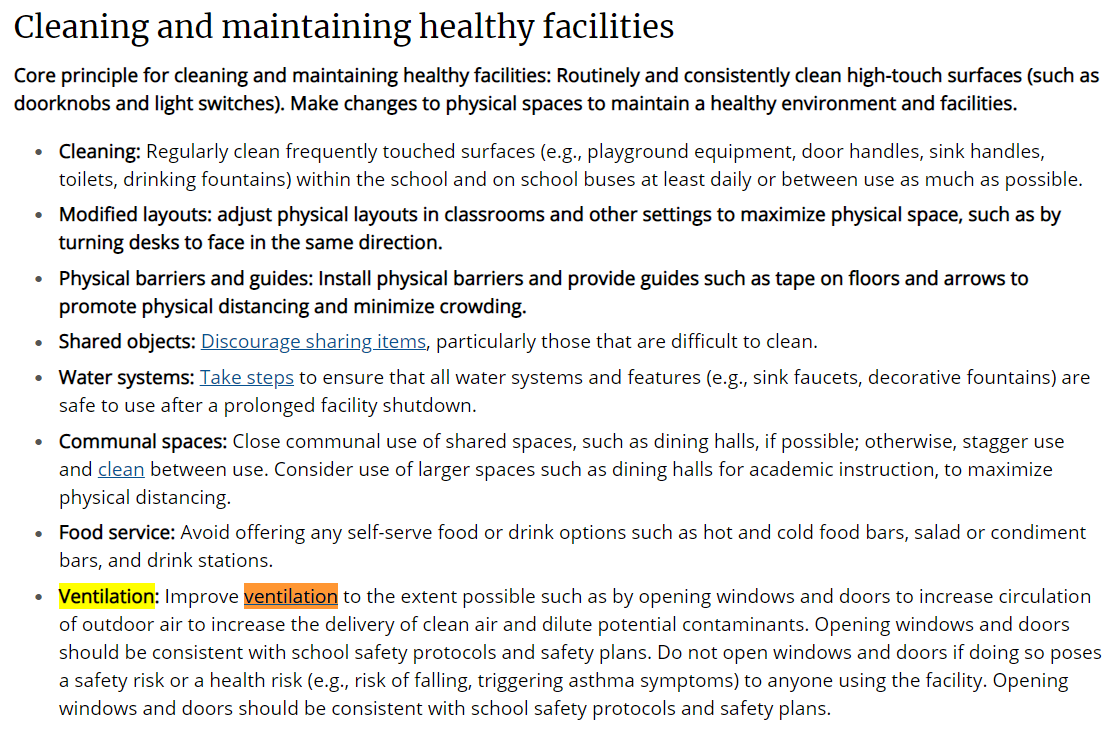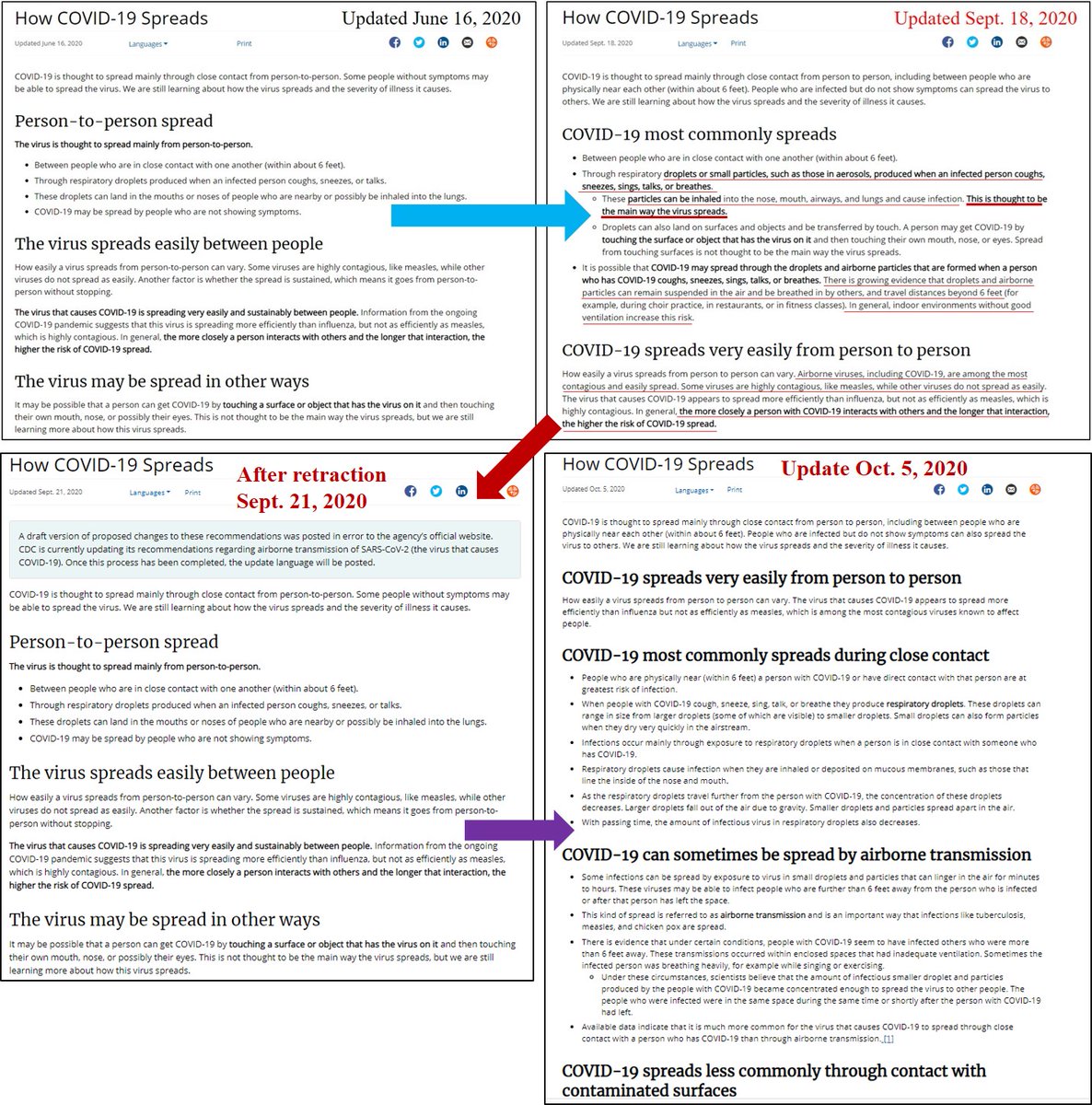
1/x Just can't shake my disappointment in yesterday's #CDC school opening guidelines: "Operational Strategy for #K12 Schools through Phased Mitigation"
A 🧵 with other thoughts, links, practical tips wrt #school COVID airborne health, beyond CDC guidance.
nytimes.com/2021/02/12/hea…
A 🧵 with other thoughts, links, practical tips wrt #school COVID airborne health, beyond CDC guidance.
nytimes.com/2021/02/12/hea…
2/ First, here is the link to updated #K12 guidelines, as well as a few other key #CDC pages (w/ last update as of today).
K12 update (2/12): cdc.gov/coronavirus/20…
How COVID spreads (10/28/20): cdc.gov/coronavirus/20…
Ventilation in buildings (2/9): cdc.gov/coronavirus/20…
K12 update (2/12): cdc.gov/coronavirus/20…
How COVID spreads (10/28/20): cdc.gov/coronavirus/20…
Ventilation in buildings (2/9): cdc.gov/coronavirus/20…
3/ So many lines of thought to follow, but I will direct you to short thread yesterday by @CorsIAQ for a good summary. The gist is simply that the #CDC guidelines leave out some of the most important, obvious help b/c they ignore the airborne component.
https://twitter.com/CorsIAQ/status/1360428143014600704
4/ The decision to open schools is complex, controversial, & emotional. Everyone wants students & teachers to be safe. The gist of all reputable reports on school re-opening is a layered approach, but critical to address the airborne component of spread.
schools.forhealth.org/risk-reduction…
schools.forhealth.org/risk-reduction…
5/ With seemingly limitless access to basic knowledge on the importance of limiting airborne spread of COVID, aerosol-knowledgeable scientists are just pulling out their hair that the CDC guidelines basically ignore this critical piece of the puzzle.
english.elpais.com/society/2020-1…
english.elpais.com/society/2020-1…
6/ “CDC’s operational strategy is grounded in science & the best available evidence” Dr. Rochelle Walensky, CDC director
Unfortunately, I don't yet agree. I was so hopeful we had turned a corner with the new #CDC admin.
Article via @apoorva_nyc et al.
nytimes.com/2021/02/12/hea…
Unfortunately, I don't yet agree. I was so hopeful we had turned a corner with the new #CDC admin.
Article via @apoorva_nyc et al.
nytimes.com/2021/02/12/hea…
7/ New #CDC school guidelines discuss various key processes to have in place, but only mentions "ventilation" in one line and never uses the word 'airborne', 'aerosol' and never hints further at the idea that virus could (much less, likely will) be transmitted beyond 6 ft. 



8/ Mortally dangerous oversites by these #CDC guidelines remove encouragement for schools to do the right (& often easy) things to improve airborne safety. See detailed guides above (Tw4) by @HarvardChanSPH @j_g_allen.
Simple example: Install portable air FILTERS in classrooms.
Simple example: Install portable air FILTERS in classrooms.
9/ Tons of info available on airborne safety in schools. Here's another on the subject that also discusses portable air filtration & other tips via @j_g_allen.
From October, by @MarkALieberman
edweek.org/leadership/air…
From October, by @MarkALieberman
edweek.org/leadership/air…
10/ Today, @polsiewski made a nice thread on the importance of air filters, also borne out of frustration about the #CDC guidelines.
https://twitter.com/polsiewski/status/1360585395793182726
11/ Earlier this week I made a thread highlighting the importance of portable air filtration in classrooms. This 👇 shows data from a study where HEPA filters were used in a HS classroom; I also included other helpful practical tips & links.
https://twitter.com/HuffmanLabDU/status/1359893167105970178
12/ This is an oft-shared guide for choosing portable air filters for classrooms and other indoor spaces.
Interactive tool by: @j_g_allen @cedenolaurent @ShellyMBoulder
docs.google.com/spreadsheets/d…
Interactive tool by: @j_g_allen @cedenolaurent @ShellyMBoulder
docs.google.com/spreadsheets/d…
13/ And there are lots of relatively inexpensive ways to supplement filtration as well. You may have seen various examples of these #boxfilter fans, which also can do an excellent job of removing particles from air.
covidstraighttalk.org/boxfanairfilter
covidstraighttalk.org/boxfanairfilter
14/ A great thing about air filtration (central or portable) is that it also reduces harmful particles of all kinds (airborne virus, air pollution, wildfire smoke). Lots of evidence to school health benefits.
Example, by @mattyglesias (from Jan 2020)
vox.com/2020/1/8/21051…
Example, by @mattyglesias (from Jan 2020)
vox.com/2020/1/8/21051…
15/ Lots of other threads pouring out thoughts and frustrations about these new #CDC guidelines. Here is a useful one from @DrEricDing:
https://twitter.com/DrEricDing/status/1360343218177646597
16/ And another thread of useful thoughts from @apoorva_nyc:
https://twitter.com/apoorva_nyc/status/1360641570580627457
17/ For decisions about COVID school safety, we need to pay much more attention to spread through the air than via surfaces. Misguided focus on deep-cleaning leads to #hygienetheater and a false sense of security.
Nice article by @dyanilewis
nature.com/articles/d4158…
Nice article by @dyanilewis
nature.com/articles/d4158…
18/ We also need to focus on #bettermasks, encouraging both good FILTRATION and FIT. Again, countless articles and resources here. I gathered a thread of links and practical tips here recently:
https://twitter.com/HuffmanLabDU/status/1357816930569129985
19/ In contrast, do NOT rely on plexiglass or other barriers to prevent air spread. These can stop sprayed drops from hitting your face, but won't stop small aerosols that flow like smoke.
An article on the subject by @jvchamary: forbes.com/sites/jvchamar…
An article on the subject by @jvchamary: forbes.com/sites/jvchamar…
https://twitter.com/KatBrezler/status/1360324184891662341
20/ Unfortunately, this struggle with the #CDC is not new. Here is just a sampling of the back-and-forth evolution through parts of last year on general guidelines wrt COVID spread through:


21/ I can empathize with this perspective of the public's frustrated confusion about masks, ventilation, school guidelines, etc.
Via @BumblinBookworm
Via @BumblinBookworm
https://twitter.com/BumblinBookworm/status/1359813094621409280
22/ The confusion from the #CDC guidelines (and far beyond) makes me whimsically think of how Horton from #DrSeuss might have been treated had he detected an airborne virus and not a tiny 'Who'. #COVIDisAirborne 

23/ Ultimately, the CDC is making progress since the depths of last year, but much progress remains. The lives of our children, teachers, & communities still hang in balance. As @CorsIAQ wisely encouraged yesterday
"Keep moving forward, even when others are moving backward."
"Keep moving forward, even when others are moving backward."
24/ Another really excellent thread on filtration and ventilation in schools just came out from @CorsIAQ.
These are not intractable problems. Prof. Corsi & others have been doing this work and shouting about it for a long time. The trick is to listen.
These are not intractable problems. Prof. Corsi & others have been doing this work and shouting about it for a long time. The trick is to listen.
https://twitter.com/corsiaq/status/1360685174883667969
• • •
Missing some Tweet in this thread? You can try to
force a refresh







